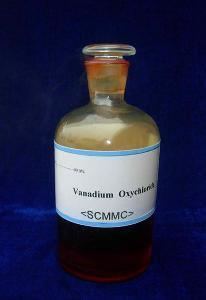Molar mass 173.3 g/mol Density 1.83 g/cm³ | Formula VOCl3 | |
 | ||
Related vanadiums Appearance Vivid orange, transparent liquid | ||
Vanadium oxytrichloride is the inorganic compound with the formula VOCl3. This distillable liquid hydrolyzes readily in air and is a strong oxidant. It is used as a reagent in organic synthesis.
Contents
Properties
VOCl3 is a vanadium compound with vanadium in the +5 oxidation state and as such is diamagnetic. It is tetrahedral with O-V-Cl bond angles of 111° and Cl-V-Cl bond angles of 108°. The V-O and V-Cl bond lengths are 157 and 214 pm, respectively. VOCl3 is highly reactive toward water and evolves HCl upon standing. It is soluble in nonpolar solvents such as benzene, CH2Cl2, and hexane. In some aspects, the chemical properties of VOCl3 and POCl3 are similar. One distinction is that VOCl3 is a strong oxidizing agent, whereas the phosphorus compound is not.
Preparation
VOCl3 is synthesized by the chlorination of V2O5. The reaction proceeds at c. 600 °C:
3 Cl2 + V2O5 → 2 VOCl3 + 1.5 O2When the V2O5 is used as an intimate mixture with carbon, the synthesis proceeds at 200–400 °C; in this case the carbon serves as a deoxygenation agent akin to its use in the Kroll process for the manufacturing of TiCl4 from TiO2.
Vanadium(III) oxide can also be used as a precursor:
3 Cl2 + V2O3 → 2 VOCl3 + 0.5 O2A more typical laboratory synthesis involves the chlorination of V2O5 using SOCl2.
V2O5 + 3 SOCl2 → 2 VOCl3 + 3 SO2Hydrolysis and alcoholysis
Vanadium oxytrichloride quickly hydrolyzes resulting in vanadium pentoxide and hydrochloric acid. In the picture, orange V2O5 can be seen forming on the walls of the beaker. An intermediate in this process is VO2Cl:
2 VOCl3 + 3 H2O → V2O5 + 6 HClVOCl3 reacts with alcohols especially in the presence of a proton-acceptor (e.g. Et3N) to give alkoxides:
VOCl3 + 3 ROH → VO(OR)3 + 3 HCl (R = Me, Ph, etc.)Interconversions to other V-O-Cl compounds
VOCl3 is also used in the synthesis of VOCl2.
V2O5 + 3 VCl3 + VOCl3 → 6 VOCl2Dioxovanadium monochloride can be prepared by an unusual reaction involving Cl2O.
VOCl3 + Cl2O → VO2Cl + 2 Cl2At >180 °C, VO2Cl decomposes to V2O5 and VOCl3. Similarly, VOCl2 also decomposes to give VOCl3, together with VOCl.
Adduct formation
VOCl3 is strongly Lewis acidic, as demonstrated by its tendency to form adducts with various bases such as MeCN and amines. In forming the adducts, vanadium changes from four-coordinate tetrahedral geometry to six-coordinate octahedral geometry:
VOCl3 + 2 H2NEt → VOCl3(H2NEt)2VOCl3 in alkene polymerization
VOCl3 is used as a catalyst or precatalytst in production of ethylene-propylene rubbers (EPDM).
